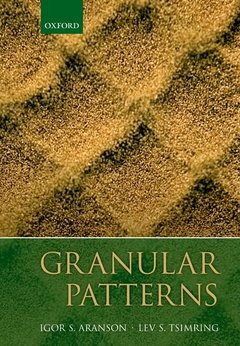Description
Granular Patterns
Authors: Aranson Igor, Tsimring Lev
Language: English
Subject for Granular Patterns:
Granular Patterns
Publication date: 07-2014
360 p. · 17.4x24.6 cm · Paperback
Publication date: 07-2014
360 p. · 17.4x24.6 cm · Paperback
155.51 €
Subject to availability at the publisher.
Add to cart
Granular patterns
Publication date: 03-2009
354 p. · 17.7x25.3 cm · Hardback
Publication date: 03-2009
354 p. · 17.7x25.3 cm · Hardback
Description
/li>Contents
/li>Biography
/li>Comment
/li>
This book is a systematic introduction to a new and exciting field of patterns in granular matter. Granular materials are collections of discrete macroscopic solid grains with a typical size large enough that thermal fluctuations are negligible. Despite this seeming simplicity, properties of granular materials are different from conventional solids, liquids and gases due to the dissipative and highly nonlinear nature of forces among grains. The last decade has seen an explosion of interest to nonequilibrium phenomena in granular matter among physicists, both on the experimental and theoretical side. Among these phenomena, one of the most interesting is the ability of granular matter upon mechanical excitation to form highly ordered patterns such as ripples, avalanches, or bands of segregated materials. This book presents a comprehensive review of experiments and novel theoretical concepts needed to understand the mechanisms of pattern formation in granular materials. This book is written for experienced physicists interested in this new rapidly developing field, as well as young researchers and graduate students entering this field. We hope that both experimentalists and theorists already working in the field will find it useful.
1. Introduction. 2. Experimental overview of patterns in granular matter. 3. Main theoretical concepts and tools. 4. Phase transitions, clustering, and coarsening in granular gases. 5. Surface waves and patterns in vibrated layers of granular materials. 6. Patterns in gravity-driven dense granular flows. 7. Patterns in granular segregation. 8. Granular materials with complex interactions. 9. Granular physics of biological objects.
Igor Aranson graduated from the Gorky State University with M.Sc. in Physics in 1982. In 1987 he obtained his Ph.D. degree in Physics and Mathematics from the Institute of Applied Physics, Academy of Science, Gorky, for a dissertation on the stochastic dynamics of structure in nonequilibrium media. He has published more than 120 research papers and several book chapters, and holds two U.S. patents. In 1991 Igor Aranson moved to Israel, where he worked at the Hebrew University of Jerusalem and then at Bar Ilan University. He moved to Argonne National Laboratory, USA, in 1996, where he has remained ever since as a Staff Scientist at the Materials Science Division. He is recipient of several international fellowships, including Alexander-von-Humboldt fellowship (Germany), Wolfson and Guastello fellowships (Israel). He was selected to Fellows of the American Physical Society in 2002. Lev Tsimring graduated from the Gorky State University with M.Sc. in Physics in 1980. In 1986 he obtained his Ph.D. degree in Physics and Mathematics from the Moscow Institute of Oceanology for a dissertation on the nonlinear theory of internal and surface wave dynamics in the Ocean. After that he was working in various areas of nonlinear dynamics, pattern formation, spatio-temporal chaos, biophysics, and nonlinear time series analysis. He has published more than 120 research papers and several book chapters, edited a book on nonlinear dynamics of digital communication devices, and he holds four U.S. patents. In 1992 L. S. Tsimring moved to San Diego, USA, where he has remained ever since as a Research Scientist at the Institute for Nonlinear Science at the University of California, San Diego.
I enthusiastically recommend Granular Patterns to graduate students and researchers working on pattern formation or with granular media. The book is very useful, and having it at hand will foster appreciation of granular patterns and help researchers push the boundaries of that truly rich and fascinating subject.
© 2024 LAVOISIER S.A.S.
These books may interest you

Handbook of Granular Materials 87.11 €

Handbook of Granular Materials 232.80 €

Mechanics of Granular Media 158.24 €

